Management of Bites and Stings
If you or a family member has been bitten or stung, the injury can range from a mild irritation to a serious, even life-threatening, wound. It’s important to know what to do.
Bee and wasp stings
Bee and wasp stings can be very painful, and in some people can cause a dangerous allergic reaction. Find out how to avoid getting stung, and what to do to treat the sting.
Honey bees and bumble bees only sting if provoked (stood on or picked up), while wasps can be aggressive and sting more than once.
Bees leave their stinger with a venom sac in your skin, but wasps do not. Most stings itch or hurt for one or two days. The swelling may last a week.
Allergy to stings
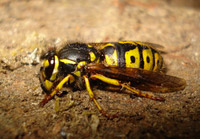 Wasp, photo by Phil Bendle /CC BY-NC-ND 3.0.
Wasp, photo by Phil Bendle /CC BY-NC-ND 3.0.
A bee or wasp sting is a minor irritation for most people. However, some people are especially sensitive and may develop a severe allergic reaction called anaphylaxis.
Call 111 for an ambulance if you or someone else has been stung and has symptoms of a serious allergic reaction or anaphylaxis.
These symptoms include:
- swelling around the lips and eyes
- rapid development of a rash
- shortness of breath or wheezing
- chest tightness
- severe dizziness or faints
- persistent sneezing or coughing
- hoarse voice
- difficulty swallowing or throat tightness
- signs of shock (pale skin, rapid pulse and fainting).
Self care for stings
- For a bee sting, scrape the stinger out using your fingers, a credit card or the blunt side of a knife. Avoid squeezing the sac as this will inject more venom.
- Wash the area with soap and cold water.
- To relieve stinging use an anti-sting ointment such as Soov (unless the bite is near your eyes), a paste made of baking soda and cold water, or an ice cube for 20 minutes.
- Apply ice compresses every two to three hours to reduce swelling and pain.
- If necessary, take pain relief such as Panadol.
- Antihistamines such as Telfast, Claratyne and Phenergan may relieve itching and swelling. A cream with hydrocortisone will reduce inflammation. You can get these from your pharmacy.
Medicine precautions
- Do not give aspirin (acetylsalicylic acid) or aspirin-containing products to anyone 18 years or younger because of the risk of a serious illness called Reye's syndrome.
- Take non-steroidal anti-inflammatory drugs (NSAIDs) with food or milk to prevent stomach irritation. Do not give NSAIDs to anyone with:
- NSAID-induced asthma
- increased risk of bleeding, such as ulcer disease, a bleeding disorder, if taking blood thinners (anticoagulants), or following surgery, significant trauma or major dental work
- an allergy to NSAIDs.
When to see your doctor
Call your doctor if you have been stung and have:
- swelling in your eyelids, lips or genitals
- signs of infection: increasing pain, redness, swelling, red streaks leading away from the sting, heat, discharge of pus, fever or chills
- pain that is not controlled by following the self-care instructions
- any new or worsening symptoms.
Allergy to stings
If you have ever had an anaphylactic reaction to a sting, you should always carry a kit containing adrenaline (epi-pen), ventolin and antihistamine. Your doctor can prescribe these for you.
Hypo-sensitisation therapy (immunotherapy) is also available. Your doctor will regularly give you small amounts of bee venom to stop your body reacting so badly to it in the future.
Insect bites
An insect bite is usually a red itchy bump. There may be a blister in the middle. Sometimes insect bites are painful (especially spider bites) as well as itchy.
How do you get insect bites?
Bites from insects such as mosquitos, fleas or from spiders.
What to do
- Check and clean every day.
- Wash the bite with cool water.
- Keep your child’s nails short and clean.
- Do things to stop the itching like soaking in a cool bath, or putting calamine lotion or aloe vera on the bites.
- Treat pets for fleas.
- Put mosquito nets around beds, put insect screens on windows and close windows at night.
- Wear close-fitting cotton sleeves or pyjamas.
- Use children’s insect repellent.
- Go to the doctor if the insect bite is near the eye.
What to do if it gets worse
Go to the doctor if any of these things happen:
- the bites last more than two weeks
- the red, swollen area keeps getting bigger or more painful
- there is pus in the bite.
This could be a serious skin infection such as cellulitis.
Jellyfish stings
There are several kinds of jellyfish found in New Zealand – and some can deliver a painful sting. Find out which jellyfish to watch out for, and what to do if you or a family member gets stung.
The lion’s-mane jellyfish is a common stinging jellyfish. It can be found in colours from white to deep blue. It grows to almost 2 m across. Its tentacles can be up to 5 m long and are almost invisible.
The mauve stinger has only few stinging catch tentacles. It can grow to 40 cm across.
The Portuguese man-of-war (blue bottle) has a burning sting. It’s not a true jellyfish, which means there are some things you should do differently to treat the sting. These are described below.
Call 111 for an ambulance if you or someone else has been stung and has symptoms of a serious allergic reaction or anaphylaxis.
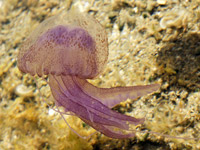 Mauve stinger, photo by Hans Hillewaert / CC-BY-SA-3.0.
Mauve stinger, photo by Hans Hillewaert / CC-BY-SA-3.0.
These symptoms include:
- swelling around the lips and eyes
- rapid development of a rash
- shortness of breath or wheezing
- chest tightness
- severe dizziness or faints
- persistent sneezing or coughing
- hoarse voice
- difficulty swallowing or throat tightness
- signs of shock (pale skin, rapid pulse and fainting).
Self care for jellyfish stings
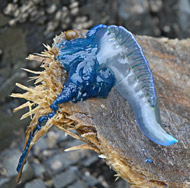 Washed-up blue bottle, photo by Pappito at en.wikipedia /CC-BY-SA-3.0.
Washed-up blue bottle, photo by Pappito at en.wikipedia /CC-BY-SA-3.0.
If you or a family member has been stung by a jellyfish, get out of the water and follow these steps.
- Apply wet sand or a towel soaked in sea water. If tentacles are still sticking to your skin, don’t try to pull them off.
- If you are able to warm up some sea water, pour this over the area (even urine is better than nothing!). If you can get vinegar, pour this over the stung area (butdo not use vinegar for blue bottle stings).
- Do not apply fresh water as this will activate the stingers.
- Wait five minutes and then wipe the tentacles off with a dry towel. Be careful not to get stingers on your hands – wear gloves if you have some.
- For all stings except blue bottles, apply cool compresses to the affected skin.
- For blue bottle stings, immerse the stung area in warm water (45°C) for 20 minutes.
- Elevate the affected area for 24 hours.
- If necessary, take pain relief such as Panadol.
- Antihistamines such as Telfast, Claratyne and Phenergan may relieve itching and swelling. A cream with hydrocortisone will reduce inflammation. You can get these from your pharmacy.
Medicine precautions
- Do not give aspirin (acetylsalicylic acid) or aspirin-containing products to anyone 18 years or younger because of the risk of a serious illness called Reye's syndrome.
- Take non-steroidal anti-inflammatory drugs (NSAIDs) with food or milk to prevent stomach irritation. Do not give NSAIDs to anyone with:
- NSAID-induced asthma
- increased risk of bleeding, such as ulcer disease, a bleeding disorder, if taking blood thinners (anticoagulants), or following surgery, significant trauma or major dental work
- an allergy to NSAIDs.
When to see your doctor
Call your doctor if you have been stung and have:
- increasing numbness or difficulty breathing
- signs of poisoning: abdominal pain, muscle cramps, nausea, vomiting
- signs of infection later: increasing pain, redness, swelling, red streaks leading away from the sting, heat, discharge of pus, fever or chills
- pain that is not controlled by following the self-care instructions
- any new or worsening symptoms.
Call us on 07 2811406
Spider bites
Most spiders in New Zealand are harmless, but the katipo, redback and white-tailed spiders can be harmful and should be avoided.
- It’s rare for significant problems to result from a spider bite.
- Always try to capture the spider and take it with you when you seek medical help.
Katipo spiders
 Female katipo spider, photo by Jess Costall / CC BY 2.0.
Female katipo spider, photo by Jess Costall / CC BY 2.0.
Bites
Because of the katipo’s increasing rarity and non-aggressive nature bites are rare.
Typical symptoms of katipo bites include pain at the bite site, which may spread to other areas, becoming more intense over the next few hours. People may also experience sweating, difficulty in breathing and abdominal cramps.
Redback spiders
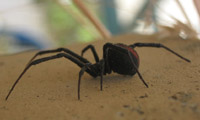 Redback spider, photo byRepat / CC BY-SA 3.0.
Redback spider, photo byRepat / CC BY-SA 3.0.
Bites
Redbacks will only bite when disturbed or trapped in clothing, and bites are rare.
The bite feels like a sharp pain similar to a pinprick. The bite may lead to localised redness, pain and sweating. Occasionally the pain and sweating may spread and stomach pain may occur. Aches in muscles and joints, nausea and vomiting, and increased heart rate and blood pressure can result.
White-tailed spider
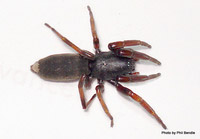 White-tailed spider, photo byPhil Bendle / CC BY-NC-ND 3.0.
White-tailed spider, photo byPhil Bendle / CC BY-NC-ND 3.0.
The usual white-tailed spider bite can be painful but the initial burning feeling, swelling, redness and itchiness at the bite site usually goes and there are no long-lasting effects.
White-tailed spider bites are not considered poisonous to humans. A recent Australian study has shown no evidence linking necrotic ulcers (destroyed skin) to white-tailed spider bites.
Catch the culprit
With all suspected spider bites it is important to know which spider may have been responsible. Try to capture the spider without endangering anybody and take it to the doctor or hospital with you, or describe it carefully for identification.
With suspect spiders:
- approach with caution – do not handle
- you may wish to use a fly spray that claims to be effective on spiders to stun the spider before killing it and/or placing it in a sealed jar.
What to do if you think you have been bitten by a katipo or redback spider
If you suspect you have been bitten by a katipo or redback spider you need to seek urgent medical attention at your nearest hospital, medical centre or doctor. Even if you do not immediately experience symptoms beyond the ‘pin prick’ of the bite you still need medical advice.
DO
- clean the wound with antiseptic or warm soapy water
- place ice on the bite (not directly onto the skin) prior to travelling.
DO NOT
- apply pressure to the wound
- consume alcohol after being bitten.
Do not panic as serious reactions are uncommon and unlikely to develop in less than three hours. Hospitals can provide safe and effective treatment. Venom is not always introduced with the bite. If it is, most reactions to the venom are moderate.
What to do if you think you have been bitten by a white-tailed spider
If you suspect you have been bitten by a white-tailed spider only simple first aid is necessary, as with any puncturing of the skin, as these spiders do not cause skin damage or ulcers:
- clean the bite area with antiseptic or warm soapy water
- place ice on the bite (not directly onto the skin) to reduce any pain or swelling.
For any suspected spider bite, see a doctor if the bite area becomes very red or painful, blisters, appears infected, or forms an ulcer. Call us on 07 2811406 for an appointment

